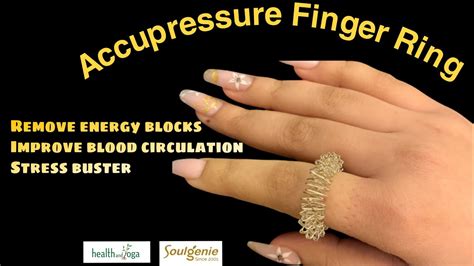Improve Circulation: The Acupressure Ring Solution
Poor circulation can significantly impact your quality of life, leading to cold hands and feet, fatigue, and even more serious health concerns. While medical intervention is necessary for severe circulatory issues, many individuals seek natural and complementary methods to improve their circulation. Acupressure rings have emerged as a popular option, but do they truly work? Let's delve into the science, benefits, and potential drawbacks of using acupressure rings to boost circulation.
What are Acupressure Rings?
Acupressure rings are typically made of materials like metal or plastic and are designed to apply gentle pressure to specific points on the body, primarily the fingers. These points correspond to acupressure points within Traditional Chinese Medicine (TCM), believed to influence the flow of energy (Qi) throughout the body. By stimulating these points, acupressure rings aim to improve blood flow and overall circulation. While often marketed for circulatory issues, they are also promoted for a range of other benefits.
How Do Acupressure Rings Work?
The purported mechanism behind acupressure rings involves stimulating specific meridians associated with circulation. According to TCM, the proper flow of Qi through these meridians is vital for good health. Applying pressure to these points, proponents believe, can unblock energy flow and improve blood circulation. The physiological effect might involve the release of endorphins, reduction of stress (a factor known to constrict blood vessels), and improved nerve signaling. However, it's crucial to understand that scientific evidence supporting these claims is limited and often anecdotal.
Do Acupressure Rings Really Improve Circulation?
The effectiveness of acupressure rings for improving circulation remains a subject of debate. While many users report positive experiences, rigorous scientific studies supporting these claims are lacking. Many of the perceived benefits might be attributed to the placebo effect. The gentle pressure and the act of wearing the ring may provide a sense of well-being, potentially masking or temporarily alleviating some symptoms of poor circulation.
What are the Benefits of Using Acupressure Rings?
While conclusive evidence is limited, some potential benefits associated with acupressure rings, based on anecdotal evidence and the principles of TCM, include:
- Improved Blood Flow: Users often report warmer hands and feet, suggesting improved peripheral circulation.
- Reduced Fatigue: Better circulation can lead to increased energy levels.
- Stress Reduction: The gentle pressure and ritual of wearing the ring may have a calming effect.
- Pain Relief: Some users report relief from certain types of pain, although this is likely indirect and related to the stress reduction aspect.
It's crucial to emphasize that these are potential benefits based on anecdotal evidence and not necessarily scientifically proven.
Are There Any Side Effects of Acupressure Rings?
Acupressure rings are generally considered safe when used correctly. However, potential side effects can include:
- Minor Discomfort: Some users may experience slight discomfort or pressure from the ring.
- Skin Irritation: Allergic reactions to the ring material are possible.
- No Effect: For some individuals, the ring may not produce any noticeable effects.
It's important to choose rings made of hypoallergenic materials and discontinue use if any adverse reactions occur.
Which Acupressure Points are Targeted?
Acupressure rings often target points on the fingers and hands associated with energy pathways related to circulation, such as points along the Pericardium and Heart meridians. However, the specific points targeted vary depending on the design and manufacturer of the ring.
What are the Alternatives to Acupressure Rings for Improving Circulation?
If you're experiencing poor circulation, it's essential to consult a healthcare professional. They can diagnose the underlying cause and recommend appropriate treatment. In addition to or alongside medical advice, other ways to improve circulation include:
- Regular Exercise: Physical activity enhances blood flow.
- Healthy Diet: A balanced diet rich in fruits, vegetables, and whole grains supports healthy circulation.
- Maintaining a Healthy Weight: Obesity can negatively impact circulation.
- Quitting Smoking: Smoking damages blood vessels and impairs circulation.
- Managing Stress: Stress can constrict blood vessels.
Conclusion
Acupressure rings offer a potentially complementary approach to improving circulation, particularly for mild symptoms. However, it's crucial to manage expectations. While some individuals may experience positive results, scientific evidence is limited. Always consult a healthcare professional for diagnosis and treatment of circulatory issues, and consider acupressure rings as a potentially supportive, rather than primary, solution. Furthermore, always prioritize lifestyle changes like exercise and a healthy diet, which are demonstrably effective in supporting healthy circulation.

